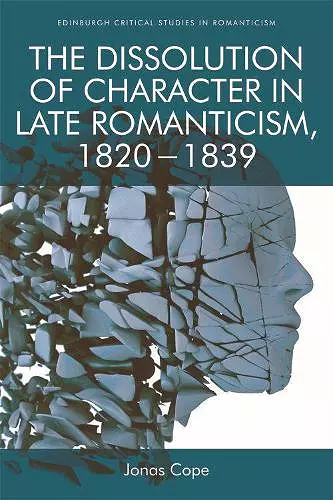The Dissolution of Character in Late Romanticism, 1820 - 1839
Format:Paperback
Publisher:Edinburgh University Press
Published:27th Nov '19
Currently unavailable, and unfortunately no date known when it will be back

Restructures and revitalises late Romantic literature as a movement fascinated with competing claims about the reality and knowability of character The idea of character that many of us still take for granted – whether considered in print as an object of representation, or in life as a congenital ‘bias’ or an acquirable moral possession – is the shared concern of a multidisciplinary debate in reform-era Britain. This book argues for the independent merits of several lesser-known works written in England and Scotland during the 1820s and 1830s, recovering in these works a sustained ideological engagement with the ever-slippery concept of character. The Dissolution of Character in Late Romanticism studies texts written by contemporary poets, novelists, essayists, journalists, philosophers, phrenologists, sociologists, gossip-mongers and anonymous correspondents. Its main authors of interest include David Hume, Walter Scott, Charles Lamb, William Hazlitt, Hartley Coleridge, Letitia Landon, Thomas Love Peacock and Thomas Lovell Beddoes. With a fresh, interdisciplinary approach, this original intervention in Romantic-era scholarship throws character into relief as an especially problematic concept, not only for the poststructuralist critics who study late Romantic writers, but also for the writers themselves. It changes the ways in which literary scholarship has thought about the development of character discourse in the first half of the nineteenth century. Key Features Describes a synthesis by which debates in many disciplines (novel-writing, periodical-writing, philosophy, phrenology, sociology, medicine, ethics) are distilled into the concept of character associated with literary realismMoves a relatively eclectic group of writers to the forefront of a literary culture traditionally narrowed to focus on Lord Byron, Percy Shelley, John Keats and their legaciesEstablishes a more comprehensive understanding of late Romantic literary networks by pairing authors rarely studied together (such as William Hazlitt and Letitia Landon)
Cope’s engaging, eye-opening study of character in post-Waterloo Britain sheds valuable new light on the evolution of public perceptions of secular figures as citizens struggled to disentangle the fictional from the real and to reconcile the myth-making tendencies of cultural representation with their hunger for luminaries as "real people." * Stephen C. Behrendt, University of Nebraska *
In short, it continues to supply new reasons why students of Romanticism or of early Victorian literature ought not neglect those years of “late Romanticism” or the “Reform era,” since they help clarify so many things that might otherwise have seemed like loose ends. Better still, Cope fillsout that biggerhistorical picture while still doing justice to the idiosyncrasy—the weird, distinctive character—of the period itself. -- John Savarese, University of Waterloo * The Wordsworth Circle 50.4 (Fall 2019 – published January 2020): *
ISBN: 9781474454827
Dimensions: unknown
Weight: 383g
248 pages